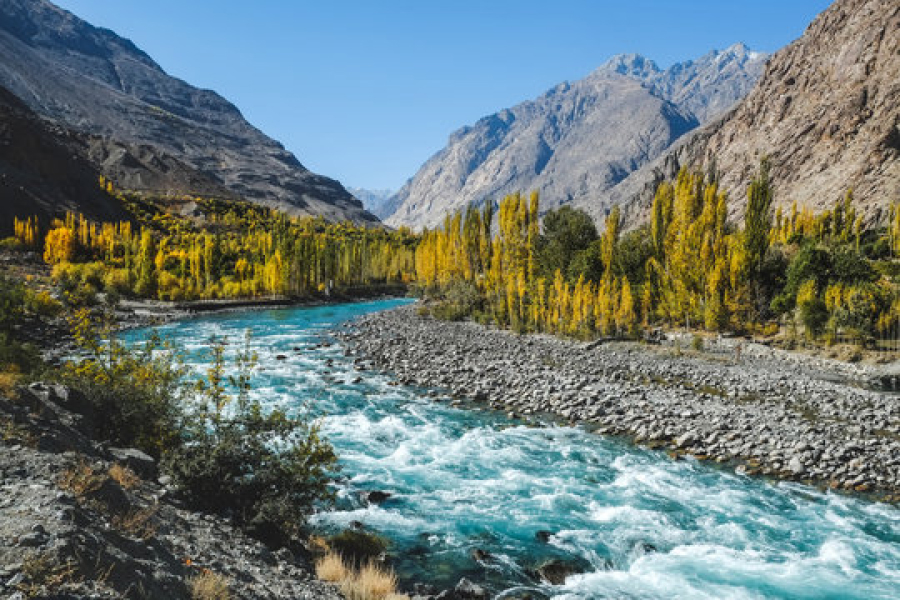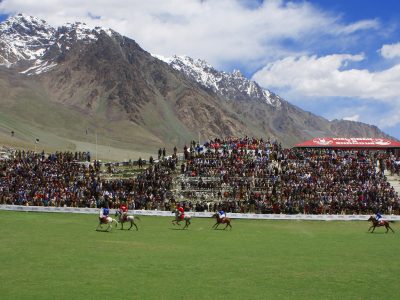All Four Seasons Gilgit Baltistan Tour Package
Nestled among the Karakoram and Himalayan ranges, Gilgit Baltistan, often termed the "Jewel of Pakistan," boasts unparalleled natural beauty. With towering peaks like Nanga Parbat, pristine lakes including Attabad, and enchanting valleys like Hunza and Skardu, the region is a haven for trekkers and adventure enthusiasts. Beyond its scenic wonders, Gilgit Baltistan unfolds a rich tapestry of history and culture featuring ancient palaces, forts, and archaeological sites. Inhabited by warm-hearted people, predominantly followers of the Ismaili sect of Islam, the region offers a unique way of life and a delectable cuisine infused with apricots and dried fruits. Gilgit Baltistan beckons as a destination promising adventure, natural beauty, and a profound cultural immersion in a land where history and traditions endure amidst the majestic mountains.
Gilgit Baltistan Location:
Gilgit Baltistan is situated in the northernmost part of Pakistan, sharing borders with India-administered Jammu and Kashmir to the southeast, the Chinese autonomous region of Xinjiang to the north and northeast, and Afghanistan's Wakhan Corridor to the west. Nestled within the Karakoram, Himalayan, and Pamir mountain ranges, this region has stunning high-altitude landscapes, including rugged peaks, pristine lakes, and deep valleys. The strategic location of Gilgit Baltistan places it at the crossroads of some of the world's mightiest mountain ranges, making it a gateway to some of the most awe-inspiring natural beauty and adventurous exploration in the region.
Gilgit Baltistan Weather: Best Time to Visit
Spring (April to June):
-
- Mild temperatures range from 10°C to 20°C.
- Blooming landscapes and blossoming flora.
- Ideal for trekking and outdoor activities.
Summer (July to September):
-
- Pleasant temperatures range from 15°C to 25°C.
- Peak tourist season with clear skies.
- Best for exploring valleys and enjoying glacial lakes.
Autumn (October):
-
- Moderate temperatures range from 10°C to 20°C.
- Spectacular foliage with golden hues.
- Ideal for trekking and cultural exploration.
Winter (November to March):
-
- Cold temperatures, often dropping below freezing.
- Snow-covered landscapes create a winter wonderland.
- Limited outdoor activities, but ideal for serene experiences.
Gilgit Baltistan Culture:
The culture of Gilgit Baltistan is a rich tapestry of traditions, beliefs, and practices that have evolved over centuries in the high mountain valleys of northern Pakistan. Influenced by its geographic isolation and the presence of diverse ethnic groups, the culture of this region is a unique blend of ancient customs, religious diversity, and communal harmony. Here are some critical aspects of Gilgit Baltistan's culture:
1. Ethnic Diversity:
- Diverse Ethnic Groups: Gilgit Baltistan is home to various ethnic communities, including Shins, Burusho, Wakhi, and Balti. Each group has its distinct customs, languages, and traditions.
2. Religion:
- Ismaili Shia Islam: The majority of the population in Gilgit Baltistan follows the Ismaili sect of Shia Islam, with the spiritual leadership of the Aga Khan. This religious affiliation plays a significant role in shaping the region's cultural practices.
3. Festivals and Celebrations:
- Nauroze: The New Year festival, Nauroze, is celebrated with great enthusiasm, marked by traditional dances, music, and feasts.
- Salgirah: The birthday of the Aga Khan is a significant celebration, bringing the community together for prayers and cultural performances.
4. Handicrafts and Art:
- Carpet Weaving: The region is renowned for its handwoven carpets and rugs with intricate designs and vibrant colours.
- Handicrafts: Local artisans create beautiful woodwork, pottery, and embroidered textiles, reflecting the artistic talents of the people.
5. Music and Dance:
- Traditional Music: The tunes of local instruments like rubab, sitar, and daf accompany traditional dances, such as the famous "Attan."
- Cultural Expressions: Folk songs and dances are integral to cultural gatherings and celebrations.
6. Hospitality:
- Warm and Hospitable: The people of Gilgit Baltistan are known for their hospitality, and guests are often welcomed with open arms.
Significant Beautiful Places in Gilgit Baltistan:
- Hunza Valley: Known for its picturesque landscapes, Hunza Valley, offers a stunning combination of towering peaks, terraced fields, and serene lakes. The iconic Baltit Fort and Altit Fort are also located in this valley.
- Skardu: Skardu is the gateway to some of the world's highest peaks, including K2. Towering mountains surround the Skardu Valley, and the Shangrila Resort is a popular attraction.
- Attabad Lake: This mesmerizing turquoise lake was formed after a landslide in 2010, and it's a must-visit for its surreal beauty. You can even take boat rides on the lake.
- Naltar Valley: Naltar Valley is famous for its lush green forests, crystal-clear lakes, and colourful Naltar Lake. It's an ideal place for hiking and camping.
- Deosai National Park: Often called the "Land of Giants," Deosai National Park is a high-altitude plateau with expansive meadows, pristine lakes, and the opportunity to spot wildlife like Himalayan brown bears.
- Fairy Meadows: As the name suggests, this place offers enchanting views of Nanga Parbat, the world's ninth-highest mountain. It's a paradise for trekkers and nature lovers.
- Shigar Fort: Shigar Fort is a historic gem converted into a museum and boutique hotel. Its grand architecture and cultural significance make it a beautiful place to explore.
- Rama Valley: Rama Valley is known for its lush greenery, serene environment, and the Rama Lake, surrounded by wildflowers, making it a charming spot for nature enthusiasts.
- Hopper Valley: Hopper Valley is home to Hopper Glacier, a striking ice formation. The valley is renowned for its diverse flora, including colourful flowers in the summer.
- Khunjerab Pass: Located on the border with China, Khunjerab Pass offers stunning vistas of the Karakoram Range. It's one of the highest border crossings in the world.
Gilgit Baltistan Tourism:
The "Crown Jewel of Pakistan" is often referred to as a region of unparalleled natural beauty and cultural richness, making it a top tourist destination. Nestled in the Karakoram and Himalayan mountain ranges, it offers various attractions, from the stunning peaks of Nanga Parbat and K2 to serene lakes like Attabad Lake and vibrant valleys such as Hunza. Adventure enthusiasts can indulge in trekking, mountaineering, and rafting. At the same time, those seeking cultural immersion can explore ancient forts, visit vibrant local bazaars, and experience the warm hospitality of the people, primarily followers of the Ismaili sect of Shia Islam. With its unique blend of landscapes, traditions, and rich history, Gilgit Baltistan is an enchanting and unmissable destination for travellers seeking natural wonders and cultural exploration.
Famous Food of Gilgit Baltistan:
The cuisine of Gilgit Baltistan reflects the region's unique culture, geography, and availability of ingredients. Some famous dishes and elements of the cooking in Gilgit Baltistan include:
- Chapshuro: A savoury pastry filled with minced meat (usually yak, mutton, or beef), green onions, and spices, Chapshuro is a popular local delicacy.
- Mantoo: These are steamed dumplings filled with minced meat and spices, often served with a flavorful sauce made from yogurt, tomatoes, and spices.
- Harisa: A hearty porridge-like dish made from whole wheat and meat (often chicken or mutton), Harisa is a warm and filling meal, continually enjoyed in the winter months.
- Gyal: A traditional soup made with wheat noodles, meat, and spices, Gyal is a comforting and nutritious dish.
- Local Fruits: Gilgit Baltistan is known for its delicious fruits, particularly apricots and cherries. Dried apricots and other dried fruits are widely consumed and used in various dishes and sweets.
- Dried Fruits and Nuts: The region produces abundant dried fruits and nuts, such as walnuts and almonds, which are integral to the local diet and used in savoury and sweet preparations.
Languages:
Gilgit Baltistan is a linguistically diverse region, with several languages spoken due to its ethnic and cultural diversity. Some of the prominent languages in the area include:
- Shina: Spoken by a significant portion of the population, Shina is a Dardic language with multiple dialects. It is the most widely used language in the region.
- Balti: Balti is the language of the Balti people, primarily spoken in Skardu and surrounding areas. It is part of the Tibetan language family and shares some linguistic features with Tibetan.
- Wakhi: The Wakhi language is spoken in the upper Hunza and Gojal valleys, with strong connections to the Wakhi-speaking communities in neighbouring regions like Wakhan in Afghanistan and Tajikistan.
- Burushaski: Burushaski is a language isolate spoken mainly in the Hunza and Nagar valleys. It is one of the few languages in the world that is not connected to any known language family.
Gilgit Baltistan Tour Package:
Day 01: Islamabad to Naran
- Start your journey from Islamabad.
- Arrive in Naran and spend the night at PTDC Motel.
Day 02: Naran to Gilgit
- Continue your trip from Naran to Gilgit.
- Stay the night at Serena Gilgit.
Day 03: Gilgit to Karimabad Hunza
- Depart from Gilgit to Karimabad in Hunza.
- Check-in at Baltit Inn for the night.
Day 04: Hunza Excursion
- Explore the stunning Hunza Valley with its beautiful landscapes and cultural sites.
- Stay overnight in Karimabad.
Day 05: Karimabad to Rama Lake Astore
- Travel to Rama Lake in Astore, enjoying the breathtaking scenery.
- Spend the night at PTDC Motel.
Day 06: Rama Lake to Serena Shigar Fort Residence via Deosai
- Depart from Rama Lake to Serena Shigar Fort Residence, passing through the Deosai Plateau.
- Enjoy the scenic beauty and stay at Shigar Fort.
Day 07: Shigar to Serena Khaplu Fort Residence
- Continue your journey from Shigar to Khaplu.
- Check-in at Serena Khaplu Fort Residence for the night.
Day 08: Khaplu to Skardu
- Travel from Khaplu to Skardu, experiencing the unique charm of the region.
- Stay the night at PTDC K2 Motel.
Day 09: Skardu Shangrila and Upper Kachura Lake Excursion
- Explore Skardu, visiting Shangrila and Upper Kachura Lake.
- Enjoy the scenic beauty and local attractions.
Day 10: Departure
- Drop off at Skardu airport for your return flight, concluding your memorable journey in Gilgit Baltistan.
This comprehensive itinerary offers a fantastic exploration of the Gilgit Baltistan region, covering its natural wonders and cultural highlights.








